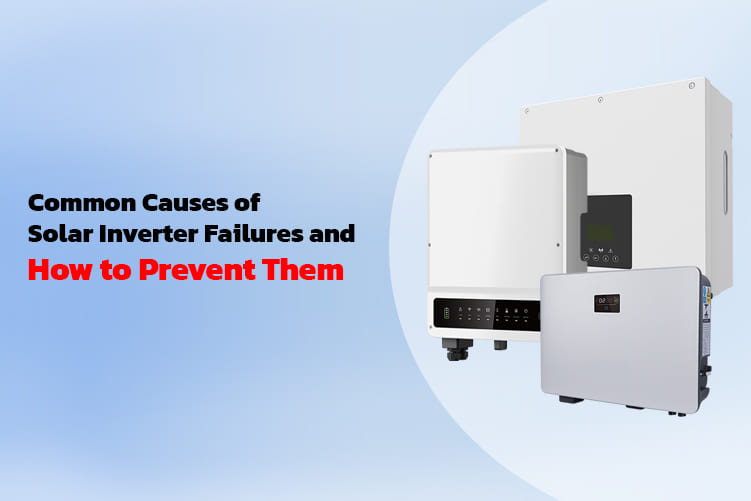In recent years, solar energy has gained immense popularity due to its environmental benefits and potential savings on electricity bills. One crucial component of a solar power system is the inverter, which converts the direct current (DC) generated by solar panels into alternating current (AC) for use in homes and businesses.
While solar inverters are built to be durable and reliable, they can sometimes fail due to various factors. Let’s explore the common causes of solar inverter failures and discuss solutions to prevent these issues.
Think of your solar inverter as the brain of your entire solar system. It’s the hardworking component that takes the raw energy from your panels and turns it into usable electricity for your home. But just like any brain, it can have its off days, and understanding why can save you a lot of headaches.
The most common culprit is often heat. If an inverter isn’t installed in a well-ventilated, shaded spot, it can get hot and grumpy, leading to a drop in performance or even a complete shutdown. Then there’s the age factor, like any electronic device, components wear out over time.
Sometimes, a simple software glitch is the problem, something that can often be fixed with a quick reset. Finally, external factors like power surges from the grid or even a simple loose connection can throw a wrench in the works.
The good news? Many of these issues are preventable with proper installation and a little bit of care, ensuring your inverter keeps humming along happily for years to come.
Causes of Solar Inverter Failures
1. Overheating:
Solar inverters are sometimes installed outdoors, where they can be exposed to harsh sunlight and high temperatures. Overheating can lead to a decrease in the inverter’s efficiency and, eventually, its failure. To prevent this, proper ventilation and shading should be considered during installation. Using heat-resistant materials and positioning the inverter in a shaded area can significantly reduce the risk of overheating.
2. Dust and Debris:
Dust, debris, and insects can accumulate in and around the inverter. This can obstruct airflow, increase operating temperatures, and potentially lead to electrical shorts. Regular cleaning and maintenance of solar panels, including dusting and cleaning the inverter’s vents, are essential to prevent these issues. Some inverters also come with protective enclosures to minimize dust and debris intrusion.
3. Voltage Spikes:
Voltage spikes in the electrical grid can damage solar inverters. Installing surge protection devices (SPDs) can safeguard the inverter against voltage surges. Additionally, regular inspection and maintenance can help identify damaged components due to voltage spikes.
4. Inverter Age:
Like any electronic device, solar inverters have a limited lifespan. Over time, components may wear out or become outdated. Regular inverter maintenance can extend its lifespan. However, when the inverter reaches the end of its life, replacing it with a newer and more efficient model is the best solution.
5. Manufacturing Defects:
In rare cases, solar inverters may fail due to manufacturing defects. These issues are typically covered by warranties, but regular monitoring and maintenance can help detect defects early, preventing system downtime.
6. Environmental Factors:
Extreme weather conditions, such as heavy rain, hail, or high humidity, can also impact the inverter’s performance. Installing the inverter in a weatherproof enclosure can protect it from environmental factors. Routine checks can help identify damage from weather conditions.
7. Poor Installation:
Improper installation, including incorrect wiring and grounding, can lead to inverter failure. Hiring a professional solar installer like Solar Miner, with experience and expertise is essential. A well-installed inverter operates efficiently and has a longer life expectancy.
8. Lack of Monitoring:
A lack of monitoring can result in delayed detection of inverter issues. Implementing a monitoring system that provides real-time data and alerts can help identify problems early, allowing for timely maintenance or replacements.
For Australians with a home solar system, understanding the common problems with solar inverters and how to address them is crucial. The inverter is the heart of your system, converting the DC power from your panels into usable AC power for your home. When it’s not working, your system isn’t producing electricity.
Here’s a breakdown of common solar inverter problems and their solutions, specifically for the Australian context.
Common Inverter Problems, Symptoms, and Solutions
Before you start troubleshooting, check your inverter’s display. Most modern inverters have a screen or a series of lights that will show a status or an error code. This information is your most valuable tool for diagnosing the problem.
- No Power Output (Dead Inverter)
- Symptoms: The inverter display is blank, or the lights are off.
- Possible Causes: This could be due to a tripped circuit breaker in your switchboard, a faulty DC or AC isolator switch, or an internal fault in the inverter itself. Inverters also turn off at night or in low light conditions, so check again during a sunny part of the day.
- Solution:
- Check Circuit Breakers: Go to your switchboard and look for a breaker labeled “Solar Supply Main Switch” or something similar. If it’s tripped (in the “off” position), try turning it back on. If it trips again, there’s a serious fault and you should contact a licensed electrician.
- Check Isolator Switches: Locate the DC and AC isolator switches near your inverter. Make sure both are in the “on” position. These switches are often located on the side or underneath the inverter.
- Perform a Manual Reset: If everything seems to be in the right position, a simple reset can often fix minor glitches. The standard procedure is to:
- Turn off the AC isolator switch (or the “Solar Supply Main Switch” in your main switchboard).
- Turn off the DC isolator switch.
- Wait for a few minutes to allow all residual power to drain.
- Turn the DC isolator back on.
- Turn the AC isolator back on.
- If the inverter does not power up after the reset, it may indicate a more serious internal fault that requires professional attention.
- Inverter Displays an Error Code
- Symptoms: Your inverter’s display shows a specific alphanumeric code.
- Possible Causes: Each code corresponds to a specific issue, which can range from minor grid faults to critical internal component failures. Common causes include:
- Grid Over/Under Voltage (e.g., Error Codes like 002, 004): Australia’s grid voltage can fluctuate. If it goes outside the inverter’s safe operating range, the inverter will shut down as a safety measure. This is often a temporary issue that resolves itself.
- Overheating (e.g., Error Codes like 036, 037): This is a very common problem in the Australian summer. Poor ventilation, a buildup of dust, or direct sunlight on the inverter can cause it to overheat and shut down.
- Isolation Fault (e.g., Error Code 039): This indicates a problem with the electrical insulation in the DC wiring, often caused by moisture, physical damage, or a faulty component.
- Solution:
- Look up the Code: Refer to your inverter’s user manual or search online for the specific error code for your inverter’s brand and model (e.g., “Fronius inverter error code 301”).
- For Grid Voltage Issues: Wait a little while. The inverter will often try to reconnect automatically once the grid voltage stabilizes. If the issue persists, contact your electricity provider.
- For Overheating: Check that the inverter is in a well-ventilated, shaded area. Clean any dust and debris from the cooling fins. If the problem continues, consider installing a small awning or moving the inverter to a cooler location.
- For Other Errors: A manual reset may clear the code. If the fault persists, it is a sign of a more serious problem, and you should contact a solar technician.
- Low or No Power Production (Even on a Sunny Day)
- Symptoms: Your monitoring app or inverter display shows very little or zero power generation, even with clear skies.
- Possible Causes: This could be due to a number of factors, including:
- Panel Shading: Even a small amount of shade from trees, a chimney, or bird droppings can significantly reduce the output of an entire string of panels.
- Dirty Panels: Dust, grime, and bird droppings are common in Australia and can reduce your system’s efficiency by up to 30%.
- Faulty Connections or Wiring: Loose connections or damaged wiring can prevent power from flowing to the inverter.
- Solution:
- Check for Shading and Clean Panels: Visually inspect your panels for any obstructions. If they are dirty, a professional cleaning service can restore their efficiency. Do not climb on your roof to do this yourself.
- Check Monitoring Data: If your system has monitoring, check the historical data to see if there’s a pattern to the underperformance. This can help pinpoint the time of day or conditions causing the issue.
- Professional Inspection: If shading and dirt are not the issue, a professional solar technician is required to check the wiring, connections, and individual panel performance.
When to Call a Professional Solar Technician
While simple resets and visual checks can fix many problems, there are times when you must call a professional.
- Recurring Faults: If a problem persists after you have tried a manual reset or if a circuit breaker keeps tripping, it’s a sign of a deeper electrical issue.
- Safety Concerns: Never try to open the inverter or tamper with the wiring yourself. Solar systems operate at high DC voltages, which can be extremely dangerous. Always use a Clean Energy Council (CEC) accredited professional for any repairs or inspections.
- Warranty Issues: Attempting to fix the inverter yourself can void the warranty. A professional will be able to diagnose the problem and submit a warranty claim on your behalf if the inverter is faulty.
Solutions to Prevent Solar Inverter Failures:
Regular Maintenance: Scheduling routine maintenance checks by a certified solar technician is crucial to detect and address issues before they escalate.
Quality Components: Investing in high-quality solar inverters and other system components is essential to ensure reliability.
Professional Installation: Hiring an experienced solar company like Solar Miner with expertise in solar installation can significantly reduce the risk of installation-related failures.
Monitoring Systems: Implementing advanced monitoring systems that offer real-time data can help you detect issues promptly.
Proper Ventilation: Ensuring the inverter has proper ventilation and is shielded from direct sunlight can help prevent overheating.
Surge Protection: Installing surge protection devices can safeguard your inverter against voltage spikes.
Environmental Considerations: Protecting the inverter from environmental factors through proper positioning and enclosures can extend its life.
In summary, solar inverter failures can result from a variety of factors, but many of these issues can be prevented with regular maintenance, professional installation, quality components, and proper monitoring. Investing in the right measures can help maximize the lifespan of your solar inverter and keep your solar energy system running efficiently for years to come.
Solar Miner is one of the most preferred solar retailers in Victoria, offering Tier 1 premium solar solutions for your property with expert installation. Get in touch with our team at 1300285885 to learn more.
In Conclusion :
hen it comes to your solar system, the inverter is its heart and soul, tirelessly converting sunlight into usable power for your home. While it can be frustrating if it stops working, understanding why can make all the difference. The main culprits are often simple: overheating, component wear from age, and electrical surges.
Think of it this way: putting your inverter in a cool, shaded, and well-ventilated spot is like giving it a comfortable home. And just like a car, getting a professional to give it a regular check-up can catch small issues before they become big problems.
Taking these steps is more than just maintenance; it’s a way to ensure your solar system keeps running smoothly, delivering clean, reliable energy for a long, long time. It’s a bit of care that goes a long way in ensuring your solar journey remains a sunny one.




